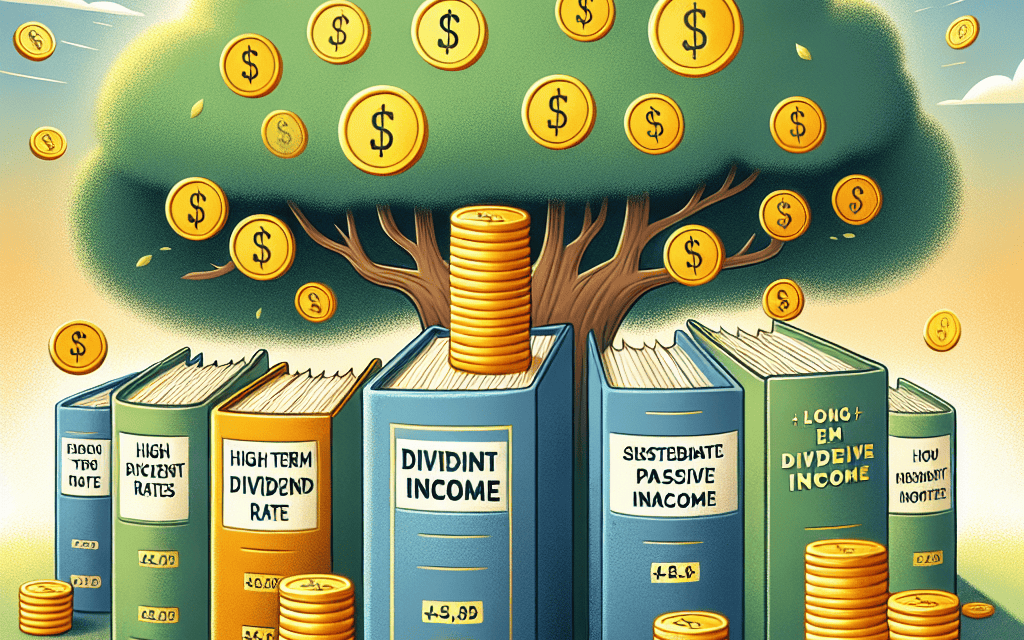“Secure Your Future: Invest in Top Dividend Stocks for Steady, Long-Term Passive Income.”
Introduction
Investing in top dividend stocks is a strategic approach for those seeking long-term passive income. Dividend stocks are shares in companies that return a portion of their earnings to shareholders in the form of regular payments, known as dividends. These stocks are often associated with established, financially stable companies that have a track record of consistent earnings and a commitment to returning value to shareholders. For investors focused on building a reliable income stream, dividend stocks offer the dual benefits of potential capital appreciation and regular income. Over time, reinvesting dividends can significantly enhance total returns, making them an attractive option for those looking to grow their wealth steadily. In this context, identifying top dividend stocks involves evaluating factors such as dividend yield, payout ratio, company financial health, and historical dividend growth. By carefully selecting stocks with strong fundamentals and a history of reliable dividend payments, investors can create a diversified portfolio that supports long-term financial goals and provides a steady income stream.
Analyzing Dividend Aristocrats: Consistent Performers for Long-Term Income
When considering investment strategies for long-term passive income, dividend stocks often emerge as a compelling option. Among these, Dividend Aristocrats stand out due to their consistent performance and reliability. These are companies that have not only paid dividends but have also increased them for at least 25 consecutive years. This remarkable track record makes them attractive to investors seeking stability and growth in their income streams. By analyzing Dividend Aristocrats, one can gain insights into how these companies maintain their dividend policies and what makes them consistent performers in the market.
To begin with, the financial health of a company is a critical factor in its ability to sustain and grow dividends. Dividend Aristocrats typically exhibit strong balance sheets, with manageable debt levels and robust cash flows. This financial stability allows them to weather economic downturns and continue rewarding shareholders. For instance, companies in sectors such as consumer staples, healthcare, and utilities often feature prominently among Dividend Aristocrats. These sectors provide essential goods and services, ensuring a steady demand regardless of economic conditions, which in turn supports consistent dividend payments.
Moreover, the management strategies of these companies play a pivotal role in their long-term success. Effective capital allocation is essential, as it ensures that the company can invest in growth opportunities while also returning capital to shareholders. Dividend Aristocrats are known for their prudent management teams that prioritize sustainable growth and shareholder value. This focus on long-term planning rather than short-term gains is a hallmark of their enduring success. Additionally, these companies often possess strong competitive advantages, such as brand recognition, economies of scale, or technological leadership, which help them maintain their market positions and profitability.
Furthermore, the commitment to dividend growth is a testament to a company’s confidence in its future earnings potential. By consistently increasing dividends, these companies signal to investors that they anticipate continued financial strength. This commitment not only attracts income-focused investors but also instills confidence in the broader market. As a result, Dividend Aristocrats often experience lower volatility compared to other stocks, providing a more stable investment option for those seeking passive income.
In addition to their financial and strategic strengths, Dividend Aristocrats benefit from a favorable tax treatment in many jurisdictions. Dividends are often taxed at a lower rate than ordinary income, making them an efficient way to generate income. This tax advantage further enhances the appeal of dividend stocks for long-term investors. However, it is important for investors to consider their individual tax situations and consult with financial advisors to optimize their investment strategies.
While Dividend Aristocrats offer numerous advantages, it is crucial for investors to conduct thorough research and due diligence. Not all Dividend Aristocrats are created equal, and factors such as payout ratios, growth prospects, and industry trends should be carefully evaluated. Diversification across different sectors and geographies can also mitigate risks and enhance the stability of the income stream.
In conclusion, Dividend Aristocrats represent a compelling option for investors seeking long-term passive income. Their consistent performance, financial stability, and commitment to dividend growth make them reliable choices in an uncertain market. By understanding the characteristics that define these companies, investors can make informed decisions and build a resilient portfolio that generates sustainable income over time.
High-Yield Dividend Stocks: Balancing Risk and Reward
Investing in high-yield dividend stocks can be an attractive strategy for those seeking long-term passive income. However, it is crucial to balance the potential rewards with the inherent risks associated with these investments. High-yield dividend stocks, by definition, offer dividend yields that are significantly higher than the average market yield. While this can lead to substantial income streams, it is essential to understand the factors that contribute to these elevated yields and the potential risks they may pose.
To begin with, high-yield dividend stocks often belong to companies operating in mature industries. These companies typically have stable cash flows and established market positions, allowing them to distribute a significant portion of their earnings as dividends. For investors, this translates into a reliable income source, which can be particularly appealing in a low-interest-rate environment. However, it is important to recognize that not all high-yield stocks are created equal. Some companies may offer high yields due to underlying financial distress or declining business prospects, which can jeopardize the sustainability of their dividend payments.
Therefore, conducting thorough due diligence is paramount when selecting high-yield dividend stocks. Investors should examine the company’s financial health, focusing on metrics such as the payout ratio, debt levels, and cash flow stability. A payout ratio that is too high may indicate that the company is distributing more than it can afford, potentially leading to future dividend cuts. Similarly, excessive debt levels can strain a company’s financial resources, making it difficult to maintain dividend payments during economic downturns. By analyzing these factors, investors can better assess the sustainability of a company’s dividend and its ability to weather financial challenges.
Moreover, diversification plays a critical role in managing the risks associated with high-yield dividend stocks. By spreading investments across various sectors and industries, investors can mitigate the impact of sector-specific downturns on their overall portfolio. This approach not only reduces risk but also enhances the potential for stable income generation. Additionally, incorporating a mix of high-yield and lower-yield, but more stable, dividend stocks can provide a balanced approach to income investing. This strategy allows investors to benefit from the higher yields while maintaining a level of security through more reliable dividend payers.
Furthermore, it is essential to consider the broader economic environment when investing in high-yield dividend stocks. Interest rates, inflation, and economic growth can all influence the performance of dividend-paying companies. For instance, rising interest rates may lead to increased borrowing costs for companies, potentially affecting their ability to sustain dividend payments. Conversely, a robust economic environment can bolster corporate earnings, supporting dividend growth. By staying informed about macroeconomic trends, investors can make more informed decisions regarding their dividend stock selections.
In conclusion, high-yield dividend stocks can be a valuable component of a long-term passive income strategy, provided that investors carefully balance the associated risks and rewards. Through diligent research, diversification, and an awareness of economic conditions, investors can enhance their chances of achieving a stable and growing income stream. While the allure of high yields is undeniable, a prudent approach that prioritizes sustainability and risk management will ultimately lead to more successful outcomes in the pursuit of long-term passive income.
Dividend Growth Stocks: Building Wealth Over Time
Investing in dividend growth stocks is a strategic approach to building wealth over time, offering a reliable stream of passive income while also providing the potential for capital appreciation. These stocks are typically issued by well-established companies with a history of paying and increasing dividends, making them an attractive option for investors seeking stability and growth. As we delve into the realm of dividend growth stocks, it is essential to understand the characteristics that make them a cornerstone of a robust investment portfolio.
To begin with, dividend growth stocks are often associated with companies that have a strong track record of financial performance. These companies usually operate in mature industries where they have established a competitive advantage, allowing them to generate consistent cash flows. This financial stability enables them to reward shareholders with regular dividend payments, which are often increased annually. Consequently, investors benefit from a growing income stream that can outpace inflation, thereby preserving purchasing power over the long term.
Moreover, the compounding effect of reinvested dividends can significantly enhance total returns. By reinvesting dividends, investors can purchase additional shares, which in turn generate more dividends. Over time, this compounding effect can lead to exponential growth in the value of an investment. This is particularly beneficial for long-term investors who are patient and willing to let their investments grow over decades.
In addition to providing a steady income, dividend growth stocks can also offer capital appreciation. Companies that consistently increase their dividends often signal financial health and confidence in future earnings. This can attract more investors, driving up the stock price. As a result, investors not only receive income from dividends but also benefit from the appreciation of their stock holdings.
Furthermore, dividend growth stocks can serve as a defensive strategy during market downturns. Historically, these stocks have shown resilience in volatile markets, as companies with strong balance sheets and cash flows are better positioned to weather economic challenges. This stability can provide a cushion against market volatility, offering investors peace of mind during uncertain times.
When selecting dividend growth stocks, it is crucial to consider several factors. First, examine the company’s dividend payout ratio, which indicates the proportion of earnings paid out as dividends. A sustainable payout ratio suggests that the company can maintain or increase its dividend payments without compromising its financial health. Additionally, assess the company’s history of dividend increases, as a consistent track record of growth is a positive indicator of future performance.
Another important consideration is the industry in which the company operates. Some sectors, such as utilities and consumer staples, are known for their stable cash flows and ability to pay dividends even during economic downturns. Diversifying across different industries can help mitigate risks and enhance the stability of an investment portfolio.
In conclusion, dividend growth stocks represent a compelling option for investors seeking long-term passive income and wealth accumulation. By focusing on companies with strong financials, a history of dividend increases, and a sustainable payout ratio, investors can build a resilient portfolio that offers both income and growth potential. As with any investment strategy, it is essential to conduct thorough research and consider individual financial goals and risk tolerance. By doing so, investors can harness the power of dividend growth stocks to achieve financial security and prosperity over time.
Sector-Specific Dividend Stocks: Opportunities in Utilities and REITs

When considering long-term passive income through dividend stocks, sector-specific investments can offer unique opportunities, particularly within the utilities and real estate investment trusts (REITs) sectors. These sectors are often favored by income-focused investors due to their stability and consistent dividend payouts. Utilities, for instance, are essential services that provide electricity, water, and natural gas, which are fundamental to daily life. This inherent necessity ensures a steady demand, allowing utility companies to generate reliable cash flows. Consequently, these companies often distribute a significant portion of their earnings as dividends, making them attractive to those seeking stable income streams.
Moreover, the regulatory environment in which utility companies operate often allows for predictable revenue streams. Governments typically regulate utility rates, providing a level of income stability that is less susceptible to economic downturns. This regulatory framework, combined with the essential nature of their services, positions utility stocks as a cornerstone for conservative dividend investors. Companies such as Duke Energy and NextEra Energy exemplify this stability, offering consistent dividends supported by robust business models and strategic investments in renewable energy, which also align with global sustainability trends.
Transitioning to the real estate sector, REITs present another compelling opportunity for dividend-seeking investors. By law, REITs must distribute at least 90% of their taxable income to shareholders in the form of dividends, which often results in higher yields compared to other sectors. This requirement makes REITs a popular choice for those looking to maximize income. Furthermore, REITs offer diversification within the real estate market, encompassing various property types such as residential, commercial, and industrial spaces. This diversity allows investors to tailor their portfolios according to specific market conditions and personal risk tolerance.
In addition to their high dividend yields, REITs provide a hedge against inflation. Real estate values and rental incomes tend to rise with inflation, which can help preserve purchasing power over time. This characteristic is particularly appealing in periods of economic uncertainty or rising inflation rates. Prominent REITs like Realty Income and Prologis have demonstrated resilience and growth, capitalizing on trends such as e-commerce expansion and the increasing demand for logistics and warehousing spaces.
While both utilities and REITs offer attractive dividend opportunities, it is crucial for investors to conduct thorough research and consider potential risks. For utilities, factors such as regulatory changes, interest rate fluctuations, and capital-intensive infrastructure projects can impact profitability and dividend sustainability. Similarly, REITs are subject to market risks, including property value fluctuations and changes in occupancy rates, which can affect their income-generating capabilities.
In conclusion, sector-specific dividend stocks in utilities and REITs provide viable options for investors seeking long-term passive income. The stability and essential nature of utility services, coupled with the high-yield potential and inflation-hedging properties of REITs, make them appealing components of a diversified income portfolio. By carefully evaluating individual companies and staying informed about sector trends, investors can harness the benefits of these sectors to achieve their financial goals. As always, a balanced approach that considers both opportunities and risks will be key to successful dividend investing in these sectors.
International Dividend Stocks: Diversifying Your Income Portfolio
Investing in international dividend stocks can be a strategic move for those seeking to diversify their income portfolios and secure long-term passive income. As global markets continue to evolve, investors are increasingly looking beyond their domestic borders to tap into the potential of international companies that offer attractive dividend yields. This approach not only provides an opportunity to benefit from the growth of foreign economies but also helps mitigate risks associated with market volatility in a single region. By diversifying geographically, investors can enhance the stability of their income streams and potentially achieve better overall returns.
One of the primary advantages of investing in international dividend stocks is the access to a broader range of industries and sectors. Different countries often have unique economic strengths, and by investing internationally, one can gain exposure to industries that may not be as prominent or accessible in their home country. For instance, an investor in the United States might find limited opportunities in sectors like telecommunications or consumer goods, which are more robust in European or Asian markets. By including international dividend stocks in their portfolio, investors can capitalize on these opportunities and benefit from the growth of diverse industries.
Moreover, international dividend stocks can offer higher yields compared to domestic options. Many foreign companies, particularly those in emerging markets, tend to distribute a significant portion of their profits as dividends. This is often due to a lack of reinvestment opportunities within their local markets, prompting them to return capital to shareholders. Consequently, investors can enjoy higher dividend payouts, which can significantly enhance their passive income over time. However, it is essential to consider the potential risks associated with currency fluctuations, as changes in exchange rates can impact the actual income received from foreign investments.
In addition to higher yields, international dividend stocks can provide a hedge against inflation. As inflation rates vary across different countries, having a diversified portfolio with international exposure can help protect against the erosion of purchasing power. For example, if inflation is rising in one country, the impact on an investor’s overall portfolio may be mitigated by stable or lower inflation rates in other regions. This balance can contribute to maintaining the real value of dividend income over the long term.
Furthermore, investing in international dividend stocks can offer tax advantages, depending on the investor’s home country and the tax treaties in place. Some countries have agreements that reduce or eliminate withholding taxes on dividends for foreign investors, thereby increasing the net income received. It is crucial for investors to understand the tax implications of their international investments and seek professional advice to optimize their tax strategies.
While the benefits of international dividend stocks are compelling, it is important to approach this investment strategy with careful consideration and due diligence. Investors should thoroughly research potential investments, taking into account factors such as the company’s financial health, dividend history, and growth prospects. Additionally, understanding the political and economic environment of the country in which the company operates is vital to assessing potential risks.
In conclusion, international dividend stocks present a valuable opportunity for investors seeking to diversify their income portfolios and achieve long-term passive income. By expanding their investment horizons beyond domestic markets, investors can access a wider array of industries, benefit from potentially higher yields, and protect against inflation. However, it is essential to conduct thorough research and consider the associated risks to make informed investment decisions.
Dividend Reinvestment Plans: Maximizing Returns Through Compounding
Dividend reinvestment plans, commonly known as DRIPs, offer a strategic approach for investors seeking to maximize returns through the power of compounding. These plans allow shareholders to automatically reinvest their cash dividends into additional shares of the underlying stock, often without incurring brokerage fees. This reinvestment strategy can significantly enhance the potential for long-term passive income, particularly when applied to top dividend stocks known for their stability and consistent payouts.
To understand the benefits of DRIPs, it is essential to grasp the concept of compounding. Compounding occurs when the earnings from an investment generate additional earnings over time. In the context of dividend stocks, reinvesting dividends means that each subsequent dividend payment is calculated based on a larger number of shares. This process can create a snowball effect, where the growth of the investment accelerates over time, leading to substantial wealth accumulation.
Moreover, DRIPs offer a disciplined investment approach. By automatically reinvesting dividends, investors can avoid the temptation to spend their dividend income, ensuring that their capital continues to work for them. This strategy is particularly advantageous during market downturns, as reinvesting dividends allows investors to purchase additional shares at lower prices, potentially increasing future returns when the market rebounds.
Furthermore, DRIPs can be a cost-effective way to build a larger position in a company over time. Many companies offer these plans directly to shareholders, often at a discount to the current market price and without transaction fees. This can result in significant savings, especially for investors who regularly reinvest dividends. Additionally, the fractional shares purchased through DRIPs enable investors to fully utilize their dividend income, ensuring that no capital is left idle.
When selecting top dividend stocks for a DRIP strategy, it is crucial to consider companies with a strong track record of dividend payments and growth. Companies with a history of increasing dividends are often financially stable and demonstrate a commitment to returning value to shareholders. These characteristics can provide a level of assurance that the dividends will continue to be paid and potentially increase over time, further enhancing the benefits of compounding.
In addition to dividend growth, investors should also evaluate the company’s payout ratio, which indicates the proportion of earnings paid out as dividends. A lower payout ratio suggests that the company retains a significant portion of its earnings for reinvestment, which can support future growth and dividend increases. Conversely, a high payout ratio may indicate that the company has limited room to raise dividends, potentially limiting the effectiveness of a DRIP strategy.
While DRIPs offer numerous advantages, it is important for investors to remain mindful of their overall investment strategy and objectives. Diversification remains a key principle, as concentrating too heavily in a single stock or sector can expose investors to unnecessary risk. Therefore, incorporating a variety of top dividend stocks across different industries can help mitigate potential risks while maximizing the benefits of dividend reinvestment.
In conclusion, dividend reinvestment plans present a compelling opportunity for investors seeking to maximize returns through compounding. By reinvesting dividends into top dividend stocks, investors can harness the power of compounding to build substantial long-term passive income. With careful selection and a disciplined approach, DRIPs can serve as a cornerstone of a successful investment strategy, providing both growth and income for years to come.
Evaluating Dividend Payout Ratios: Ensuring Sustainability and Growth
When considering top dividend stocks for long-term passive income, evaluating dividend payout ratios is a crucial step in ensuring both sustainability and growth. The dividend payout ratio, which is the proportion of earnings a company pays to its shareholders in the form of dividends, serves as a key indicator of a company’s financial health and its ability to maintain or increase dividend payments over time. A balanced payout ratio not only reflects a company’s commitment to returning value to shareholders but also its capacity to reinvest in its own growth, thereby securing future profitability.
To begin with, understanding the ideal dividend payout ratio is essential. Generally, a payout ratio between 30% and 60% is considered healthy for most industries. This range suggests that a company is distributing a reasonable portion of its earnings to shareholders while retaining enough capital to fund operations and future expansion. However, it is important to note that what constitutes an ideal payout ratio can vary significantly across different sectors. For instance, utility companies, which typically have stable cash flows, might sustain higher payout ratios, often exceeding 70%, without compromising their financial stability. Conversely, technology firms, which require substantial reinvestment for innovation and growth, might maintain lower payout ratios.
Moreover, a consistently high payout ratio could be a red flag, indicating that a company might be overextending itself to satisfy shareholder demands. This scenario can lead to reduced financial flexibility, making it challenging for the company to weather economic downturns or invest in new opportunities. On the other hand, a very low payout ratio might suggest that a company is overly conservative, potentially missing out on the opportunity to reward shareholders adequately. Therefore, investors should seek a balance, where the payout ratio aligns with the company’s growth prospects and industry standards.
In addition to the payout ratio, examining a company’s historical dividend payments can provide valuable insights into its commitment to sustaining and growing dividends. Companies with a track record of consistent or increasing dividends over several years are often more reliable, as they demonstrate resilience and a shareholder-friendly approach. Furthermore, these companies are likely to have robust cash flow management practices, ensuring that dividends are not only sustainable but also poised for growth.
Another critical aspect to consider is the company’s earnings growth potential. A company with strong earnings growth prospects is more likely to increase its dividends over time, providing investors with a rising stream of passive income. This potential can be assessed by analyzing factors such as revenue growth, profit margins, and industry trends. Companies operating in expanding markets or those with innovative products and services are often well-positioned for future earnings growth.
In conclusion, evaluating dividend payout ratios is a vital component of selecting top dividend stocks for long-term passive income. By focusing on a balanced payout ratio, assessing historical dividend performance, and considering earnings growth potential, investors can identify companies that not only offer sustainable dividends but also have the capacity for future growth. This approach ensures that investors can enjoy a reliable and potentially increasing income stream, contributing to their long-term financial goals.
Q&A
1. **What are top dividend stocks for long-term passive income?**
– Johnson & Johnson (JNJ)
– Procter & Gamble (PG)
– Coca-Cola (KO)
– PepsiCo (PEP)
– McDonald’s (MCD)
– 3M Company (MMM)
– Realty Income Corporation (O)
2. **Why is Johnson & Johnson considered a good dividend stock?**
– Johnson & Johnson has a long history of dividend increases, strong financials, and a diversified product portfolio, making it a reliable choice for long-term income.
3. **What makes Procter & Gamble a reliable dividend stock?**
– Procter & Gamble is known for its stable cash flow, strong brand portfolio, and consistent dividend growth over decades.
4. **How does Coca-Cola maintain its dividend payments?**
– Coca-Cola benefits from a global brand presence, strong market share in the beverage industry, and a history of steady cash flow, supporting its dividend payments.
5. **What is appealing about PepsiCo as a dividend stock?**
– PepsiCo offers diversification with its food and beverage segments, consistent revenue growth, and a strong track record of dividend increases.
6. **Why is McDonald’s a popular choice for dividend investors?**
– McDonald’s has a robust global franchise model, strong brand recognition, and a history of returning capital to shareholders through dividends.
7. **What makes Realty Income Corporation unique among dividend stocks?**
– Realty Income Corporation is known as “The Monthly Dividend Company” due to its consistent monthly dividend payments and focus on high-quality real estate investments.
Conclusion
Top dividend stocks for long-term passive income are typically characterized by their strong financial health, consistent earnings growth, and a history of reliable dividend payments. Companies in sectors such as consumer staples, utilities, healthcare, and telecommunications often fit this profile due to their stable demand and resilient business models. Notable examples include Johnson & Johnson, Procter & Gamble, and Coca-Cola, which have demonstrated the ability to maintain and grow dividends over time. Additionally, real estate investment trusts (REITs) and certain financial institutions can offer attractive yields. When selecting dividend stocks, investors should consider factors such as the dividend yield, payout ratio, and the company’s ability to sustain dividends through economic cycles. Diversification across industries and geographies can also help mitigate risks. Ultimately, a well-researched portfolio of top dividend stocks can provide a reliable source of passive income, contributing to long-term financial stability and growth.





